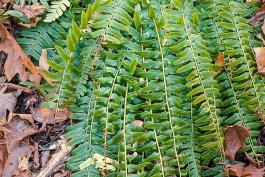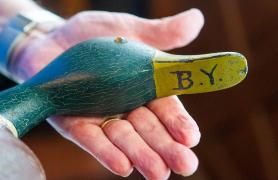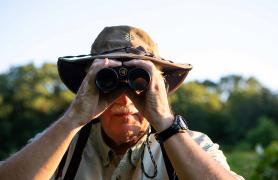Christmas Fern | Polystichum acrostichoides
Status
Common
Size
Leaves: 4 to 30 inches long; leaflets: usually 2 to 3 inches long
Distribution
Statewide
Christmas ferns, also known as holly ferns, are perennials that produce two types of leaves — ones that produce spores and ones that do not. The fertile leaflets of the fern are smaller and wither by winter. The sterile leaflets, by comparison, are larger and last through the winter, often lying flat on the ground.
The fern’s lance-shaped leaflets are spiny-toothed with bristle tips, similar to holly leaves. The spore clusters are in rows of circular, umbrella-like structures, which can be so close together that they may cover nearly the entire leaflet undersurface.
Life Cycle
Christmas ferns, like other ferns, have a two-part life cycle. The plant we see is called a sporophyte, because it produces spores. Spores, produced on the undersides of the leaves from June through October, are extremely small seedlike packages that can blow in the wind or be carried by water. When the spores germinate, they become the other part of the life cycle, the gametophyte. The gametophyte is a tiny, flat, green, heart- or kidney-shaped plant that produces eggs and sperm. The sperm must swim to reach the eggs, so water must be present for fertilization to occur. The fertilized eggs then develop into new sporophyte plants — the ferns we are accustomed to seeing.
Ecosystem Connections
During winter, the leaves of Christmas ferns hold fallen leaves against the ground, speeding their decomposition and enriching the soil. Not many animals eat the leaves of Christmas ferns, so they help stabilize slopes and prevent erosion.
Did You Know?
Christmas ferns got their name from pioneers who cultivated the plants, making them into Christmas wreaths.
Discover more nature at mdc.mo.gov/field-guide
Just because the temperatures have dipped, don’t ditch your hiking shoes. Head out to your nearest conservation area and walk the trails. With the leaves off the trees, you will see more open vistas on your trek. Listen to the birds along the way or bask in the solitude of a crisp, winter day. It’s a great time to discover nature.


Also In This Issue


This Issue's Staff
Editor - Angie Daly Morfeld
Associate Editor - Larry Archer
Staff Writer - Bonnie Chasteen
Staff Writer - Heather Feeler
Staff Writer - Kristie Hilgedick
Staff Writer - Joe Jerek
Art Director - Cliff White
Designer - Les Fortenberry
Designer - Marci Porter
Photographer - Noppadol Paothong
Photographer - David Stonner
Circulation - Laura Scheuler






















